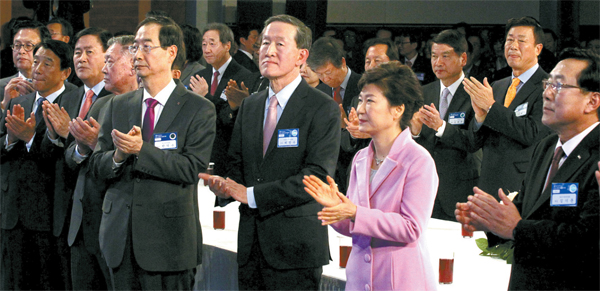Park’s three-year plan faces persistent risks

President Park Geun-hye attends the 2014 New Year’s business community greeting ceremony yesterday at COEX, southern Seoul. The greeting ceremony, one of the biggest gatherings for the business community, attracted businesses, government officials and foreign dignitaries. [Joint Press Corps]
She plans to accomplish this agenda within three years.
“If the three-year economic innovation plan is pushed as planned, our potential economic growth will reach the 4 percent level, while our gross national income per capita will surpass $30,000 and edge close to $40,000,” Park said in her first press conference of the year at the Blue House yesterday. “We will achieve a 70 percent employment rate, while jobs for women and young people will increase significantly.”
Her grand three-year plan is aligned with the policy blueprint presented by the Ministry of Strategy and Finance at the end of last year.
Park’s plan comes at a time when the Korean economy is at a crossroads: Will the country enter a deep deflation or continue the mild recovery it has been witnessing since the second quarter of 2013?
The Korean economy in 2013 is believed to have grown 2.8 percent year-on-year while exports reached new heights, thanks largely to recovery in advanced economies.
However, despite several promising indicators, there are lingering risks that could prevent the Korean economy from achieving the government’s growth target of 3.9 percent for 2014.
They include unfavorable foreign exchange rates, lack of new growth engines and ever-growing debt.
The foreign currency exchange risk was immediately realized as the stock market tumbled with the start of the year. Shares of major exporters like Samsung Electronics and Hyundai Motor slumped on fears that a strong won and the weakest Japanese yen in five years would hurt profits.
The Korean won-dollar exchange rate stabilized yesterday, weakening to 1,065.45 won.
On top of exporters losing their competitive edge as a result of the strong won, inflation saw its lowest level in 14 years at 1.3 percent in 2013, raising speculation that Korea may have already entered a period of deflation.
When asked about the currency situation during the press conference, Park, however, did not mention what steps she and her government plan on taking.
Instead, the alternative solution the president proposed was for companies to take this crisis as an opportunity to restructure, including making cost-cutting efforts while seeking new markets overseas and maximizing the benefits of free trade agreements.
Another solution she presented was to support the domestic market while reducing its export dependency, concentrating on large companies.
“It has become clear that it is difficult to create jobs and revitalize the domestic market by concentrating on manufacturing and exports,” Park said.
In addition to fostering service sectors -welfare, medical, education, tourism, finance and software - the president made it clear that she and her administration will look into regulations that hinder business expansion and investment down to the last detail.
In search of a new growth engine for the economy, she further proposed strengthening the creative economy campaign she has been emphasizing since the beginning of her term last year.
“I will create a dynamic, innovative economy through creative economy,” the president said.
During her speech, however, the president also demonstrated a strong commitment to reform in the public sector.
Many global investment banks have noted that consistently rising debt threatens Korea’s economic expansion.
Unlike other countries that have been deleveraging their debt in the private and public sectors since the global crisis in late 2008, Korea’s debts have continued to grow.
Although the debt-to-GDP ration is relatively lower than in other advanced countries such as the United States or Japan, ever-growing debt has been a major concern here.
The combined debt of 295 public companies, including Korea Railroad Corporation and LH Corp., edged close to 500 trillion won ($4.7 billion) as of the end of last year. That is nearly twice the size of the 290 trillion won reported at the end of 2008.
When adding regional public companies managed under local governments, the total debt amounts to 565 trillion won.
The business community, including the Federation of Korean Industries, welcomed Park’s strong will to reform and her intention to lift regulations that may hurt businesses.
BY LEE HO-JEONG [ojlee82@joongang.co.kr]










with the Korea JoongAng Daily
To write comments, please log in to one of the accounts.
Standards Board Policy (0/250자)